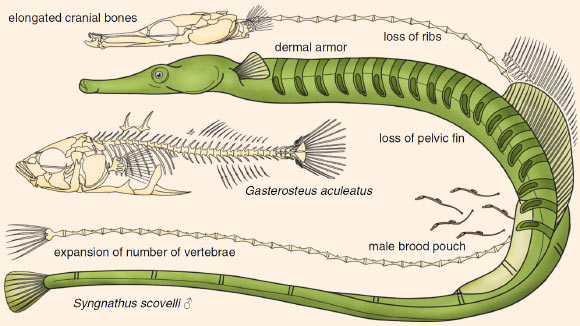A team of scientists from the University of Oregon and Texas A&M University has sequenced and explored the genome of the gulf pipefish (Syngnathus scovelli), a fish species abundant in seagrass beds of the Gulf of Mexico. The team published its results online Dec. 20 in the journal Genome Biology.

The bony armor on the body of this gulf pipefish, raised in the lab of Prof. Cresko, is not yet well ossified and appears mostly transparent; bones are stained red; cartilage is stained blue. Image credit: Mark Currey.
The gulf pipefish belongs to the fish family known as Syngnathidae (pipefishes, seahorses, and seadragons), which dates back at least 50 million years.
Species in this family have long snouts, which help their suction-like feeding behavior. They have bony body armor. They lack pelvic fins, ribs and teeth and have evolved unique placenta-like structures in males for the brooding of developing offspring.
“This group of species has novelties that are not well understood from an evolutionary genetic standpoint,” said co-author Dr. Clay Small, a postdoctoral fellow in the Institute of Ecology and Evolution at the University of Oregon.
“The family Syngnathidae is a very good model clade for studying these derived structural features because they are so weird looking in terms of their unique body plans.”
“Ultimately, we are interested in identifying genetic changes that are related to the evolution of these novel features in this whole family.”

A cartoon representation of key derived traits in pipefishes and their relatives. Syngnathid fishes such as the gulf pipefish (Syngnathus scovelli) have increased numbers of vertebrae and an elongated head, are missing pelvic fins and ribs, and have an evolutionarily novel structure, the male brood pouch. Shown for comparison is the axial skeleton of a percomorph with more typical morphology, a threespine stickleback. Note that not all derived syngnathid skeletal features are depicted in this cartoon. Image credit: C. M. Small et al, doi: 10.1186/s13059-016-1126-6.
The publication of the gulf pipefish genome came a week after the genome of the tiger tail seahorse (Hippocampus comes), another member of Syngnathidae, was announced in the journal Nature.
“Having this pair of papers published almost simultaneously moved genomic analyses of this remarkable group of fish ahead tremendously,” said senior author Prof. William Cresko, from the University of Oregon.
“The two genomes show that losses and changes in specific genes or gene functions may be responsible for evolutionary innovations,” Dr. Small added.
“Through evolution, the pipefish and seahorse genomes have lost genetic elements compared to distant fish ancestors. These likely explain some changes in body alignment and the loss of pelvic fins, which correspond to legs in the human vertebrate lineage.”
A big part of team’s efforts focused on the ability of male gulf pipefish to gestate embryos in their brood pouch.
“The gulf pipefish provides an example of one of the most elaborated placental structures found in the males of various pipefish species,” said co-author Dr. Susan Bassham, also from the University of Oregon.
Some 1,000 genes are expressed differently in the pouch during a male’s pregnancy to control developmental processes, nutrient exchange, stability and immunity.
In a comparative analysis between pregnant and non-pregnant male pipefish, the authors found a family of genes that behaved unusually.
This gene family, patristacins, contains some members that turn on during pregnancy, and others that are suppressed during pregnancy. The group of genes is likely unique to syngnathid fishes, and they behave similarly in seahorses.
The researchers also found that gulf pipefish have two chromosomes fewer than most ray-finned fish.
“By looking at the patterns of where genes lie in the genome, it’s very likely this difference resulted simply from the fusion of four of the ancestral chromosomes into two,” Dr. Bassham said.
“Most fish have 24 chromosomes, but the gulf pipefish has 22.”
_____
C. M. Small et al. 2016. The genome of the Gulf pipefish enables understanding of evolutionary innovations. Genome Biology 17: 258; doi: 10.1186/s13059-016-1126-6







